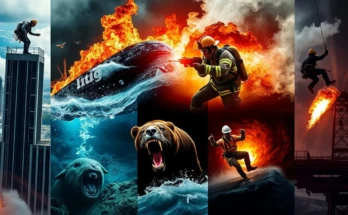Introduction
Have you ever felt the pull of ancient rituals and spiritual beliefs from distant lands? The world is filled with a rich tapestry of faiths that many people have never heard of faiths that shaped civilizations and influenced entire cultures. In this article, we’ll take you on a journey through time to explore four lesser-known religions: Zoroastrianism, Animism, Candomblé, and Shintoism. Each of these traditions offers a unique perspective on the human experience, spirituality, and our connection to the universe. Let’s dive in and uncover the magic of the past.
Zoroastrianism: The Ancient Persian Religion
A Glimpse into the Past
Zoroastrianism is one of the oldest known monotheistic religions, dating back over 3,500 years. It was founded by the prophet Zoroaster (or Zarathustra) in ancient Persia (modern-day Iran). But what makes this faith so intriguing?
The Concept of Ahura Mazda
At the heart of Zoroastrianism is the belief in Ahura Mazda, the wise lord and creator of all. This deity represents truth, light, and goodness, contrasting sharply with Angra Mainyu, the embodiment of chaos and darkness. The duality of these opposing forces good and evil is central to Zoroastrian thought.
Key Beliefs and Practices
Zoroastrians believe in the concept of free will, encouraging followers to choose between good and evil. Fire plays a significant role in their rituals, symbolizing divine light and truth. Temples called “fire temples” are built to house the sacred fire that represents Ahura Mazda. These rituals emphasize purity, truthfulness, and moral living.
Animism: The Spirit of the Earth
Understanding Animism
Have you ever felt a connection with nature that goes beyond the physical? Animism, the belief that everything plants, animals, rocks, rivers has a spirit, is a fundamental belief in many indigenous cultures around the world. This practice is more than just a religious faith; it’s a way of life.
The Role of Spirits
In animistic beliefs, every element of the natural world is believed to be inhabited by spirits or souls. These spirits are not just mythical beings; they are active participants in the world, influencing events and guiding human lives. Animism teaches a deep respect for the environment and all living things.
Rituals and Ceremonies
Rituals in animism often involve offerings, chants, and dances to communicate with spirits. Shamans, who act as intermediaries between the physical and spiritual worlds, lead these ceremonies. These practices emphasize harmony with nature and the importance of living in balance with the earth.
Candomblé: The Afro-Brazilian Religion
The Legacy of Slavery
Candomblé originated in Brazil among African slaves brought by Portuguese colonizers in the 16th century. This religion is a blend of African spiritual practices, indigenous Brazilian beliefs, and Christianity. It’s a powerful example of how cultures can merge to form something unique.
The Orishas: Deities of Candomblé
Candomblé revolves around the worship of orishas spirits that represent various natural forces, ancestors, and deities from African traditions. Each orisha has distinct characteristics and is associated with specific colors, symbols, and rituals. The most well-known orisha is Oshun, the goddess of love, fertility, and rivers.
Rituals and Offerings
Candomblé rituals involve music, dance, and drumming to invoke the orishas. These ceremonies are colorful and vibrant, with participants often entering a trance like state to communicate with the spirits. Offerings of food, flowers, and sometimes animals are made to honor the orishas.
Also Read: A Must Read for All Poultry Farmers: A Poultry Nutrition Guide
Shintoism: The Spirit of Japan
The Essence of Shinto
Shintoism is Japan’s indigenous spirituality, deeply rooted in the country’s history and culture. Unlike organized religions, Shinto has no formal doctrines or scriptures. Instead, it’s centered on rituals and practices designed to maintain harmony between the human world and the divine.

The Kami: Spirits of Shinto
At the core of Shinto are the kami spiritual beings that inhabit the natural world, including mountains, rivers, and even objects like swords and mirrors. These kami are believed to be the embodiment of natural forces and ancestors, bridging the gap between the physical and spiritual realms.
Rituals and Festivals
Shinto rituals are performed to cleanse, purify, and connect with the kami. They often include offerings of rice, sake, and other food items, as well as prayers and dances. The most famous Shinto festival is the cherry blossom festival (Hanami), which celebrates the beauty of nature and the changing seasons.
The Global Impact of These Forgotten Faiths
A Legacy Beyond Borders
Although these faiths are often overlooked in mainstream discussions of religion, their influence can be seen around the world. From the Zoroastrian-inspired duality in Western religions to the environmental consciousness of animism, these traditions have shaped our understanding of spirituality, ethics, and our place in the world.
Cross-Cultural Exchange
The blending of these faiths with other religions—like the merging of African and Brazilian traditions in Candomblé—shows how spirituality can adapt and evolve over time. The migration of people due to colonization, slavery, and trade has led to the exchange and adaptation of beliefs, creating new spiritual paths for people to follow.
Why These Forgotten Spiritual Practices Matter Today
Reconnecting with the Past
As our world becomes more interconnected, there is a growing interest in understanding and preserving these ancient spiritual traditions. They offer insights into living harmoniously with nature, understanding the divine, and fostering a sense of community. In an age of rapid technological change, these practices remind us of the importance of ritual, reverence, and connection.
Lessons for Modern Living
Practices like Zoroastrian purity rituals, the respect for spirits in animism, and the focus on balance in Shinto can provide a framework for living a more mindful, sustainable life. These traditions teach us that spirituality is not just about belief; it’s about how we live, how we treat others, and how we relate to the world around us.
Human Evolution: Stone Tools Used by Early Humans and Monkeys
Conclusion
Uncovering these forgotten spiritual practices isn’t just an academic exercise it’s a journey into the soul of humanity. Each of these faiths offers a unique perspective on our shared human experience, showing that there is more than one way to see the world and our place in it. By understanding these traditions, we can gain a deeper appreciation for the diversity of human spirituality and the ways it shapes our lives.
FAQs
- What is the significance of fire in Zoroastrianism?
- Fire is a powerful symbol of divine light and truth in Zoroastrianism. It represents the purity and wisdom of Ahura Mazda and is used in rituals to maintain contact with the divine.
- How do animistic beliefs influence daily life?
- Animistic beliefs encourage a deep connection with nature. They influence practices such as farming, where respect for the spirits of plants and animals is crucial for a bountiful harvest.
- What role do orishas play in Candomblé rituals?
- Orishas in Candomblé are honored through music, dance, and offerings. Each orisha embodies different aspects of nature and life, such as love, war, and fertility, and guides adherents in their spiritual journey.
- Why is Shinto considered a “way of life” rather than a religion?
- Shintoism focuses on daily rituals, ceremonies, and maintaining harmony with the natural world rather than dogma or organized worship. It emphasizes purity, gratitude, and respect for the kami, making it more of a way of life than a traditional religion.
- Can these faiths coexist with modern religions?
- Yes, many people practice these faiths alongside other religions, such as Christianity, Islam, or Buddhism. These ancient traditions are adaptable and can be integrated into modern spiritual practices, enriching believers’ lives with diverse perspectives on the divine.


